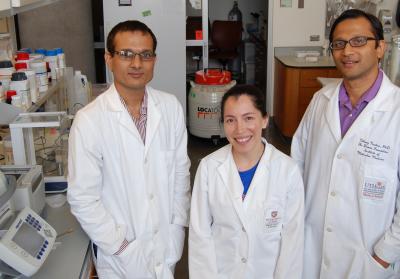Scientists discover genetic switch that can prevent peripheral vascular disease in mice

Working to develop a new treatment for peripheral vascular disease from left to right are UTHealth researchers Vikas Yadav, Ph.D., Sabina Lorca and Vihang Narkar, Ph.D. Credit: The University of Texas Health Science Center at Houston (UTHealth)
At The University of Texas Health Science Center at Houston (UTHealth) Medical School, scientists tested a non-surgical preventative treatment in a mouse model of the disease and it was associated with increased blood circulation. Their proof-of-concept study appears in the journal Cell Reports.
Unlike previous studies in which other investigators used individual stimulatory factors to grow blood vessels, Vihang Narkar, Ph.D., senior author and assistant professor in the Department of Integrative Biology and Pharmacology at the UTHealth Medical School, identified and turned off a genetic switch that stifles blood vessel development.
“We discovered an inhibitory switch that degrades blood vessels,” said Narkar, whose laboratory is in the UTHealth Center for Metabolic and Degenerative Diseases at The Brown Foundation Institute of Molecular Medicine for the Prevention of Human Diseases. “We were able to genetically turn it off to prevent peripheral vascular disease in a preclinical study.”
Added Narkar, “Our next step will be to test this targeted treatment in models of other conditions that dramatically decrease circulation like diabetes and atherosclerosis.”
Narkar said using individual growth factors to stimulate blood vessel growth often leads to the formation of leaky and non-functional blood vessels. “By turning off a genetic switch that acts as a roadblock for blood vessel growth, we were able to trigger and accelerate the natural process of blood vessel regeneration that involves a battery of growth factors,” he said.
The switch is called peroxisome proliferator-activated receptor gamma co-activator 1 beta (PGC1beta) and could be a key to future treatments for additional conditions like cardiac myopathies, cancer and retinopathy.
Narkar's UTHealth co-authors are Vikas Yadav, Ph.D. (lead author), Antonios Matsakas, Ph.D., and Sabina Lorca. Narkar is on the faculty of The University of Texas Graduate School of Biomedical Sciences at Houston.
The study titled “PGC1beta activates anti-angiogenic program to repress neo-angiogenesis in muscle ischemia” received support from the American Heart Association (AHA#11SDG7600213), American Diabetes Association (ADA#1-13-BS-127) and Muscular Dystrophy Association (MDA#174408).
Media Contact
All latest news from the category: Life Sciences and Chemistry
Articles and reports from the Life Sciences and chemistry area deal with applied and basic research into modern biology, chemistry and human medicine.
Valuable information can be found on a range of life sciences fields including bacteriology, biochemistry, bionics, bioinformatics, biophysics, biotechnology, genetics, geobotany, human biology, marine biology, microbiology, molecular biology, cellular biology, zoology, bioinorganic chemistry, microchemistry and environmental chemistry.
Newest articles

Sea slugs inspire highly stretchable biomedical sensor
USC Viterbi School of Engineering researcher Hangbo Zhao presents findings on highly stretchable and customizable microneedles for application in fields including neuroscience, tissue engineering, and wearable bioelectronics. The revolution in…

Twisting and binding matter waves with photons in a cavity
Precisely measuring the energy states of individual atoms has been a historical challenge for physicists due to atomic recoil. When an atom interacts with a photon, the atom “recoils” in…

Nanotubes, nanoparticles, and antibodies detect tiny amounts of fentanyl
New sensor is six orders of magnitude more sensitive than the next best thing. A research team at Pitt led by Alexander Star, a chemistry professor in the Kenneth P. Dietrich…





















